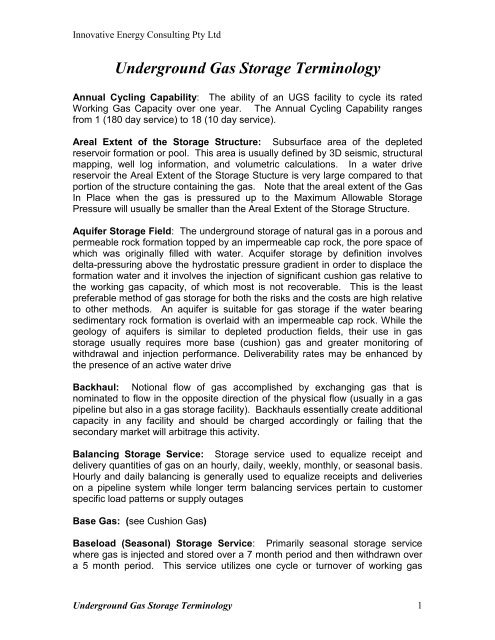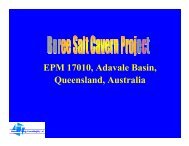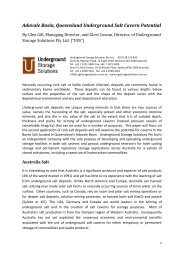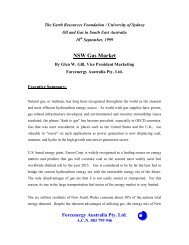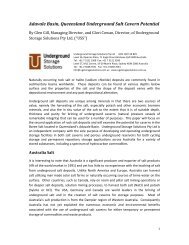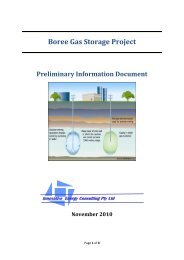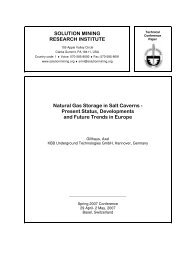Underground Gas Storage Glossary - Innovative Energy Consulting ...
Underground Gas Storage Glossary - Innovative Energy Consulting ...
Underground Gas Storage Glossary - Innovative Energy Consulting ...
Create successful ePaper yourself
Turn your PDF publications into a flip-book with our unique Google optimized e-Paper software.
<strong>Innovative</strong> <strong>Energy</strong> <strong>Consulting</strong> Pty Ltd<strong>Underground</strong> <strong>Gas</strong> <strong>Storage</strong> TerminologyAnnual Cycling Capability: The ability of an UGS facility to cycle its ratedWorking <strong>Gas</strong> Capacity over one year. The Annual Cycling Capability rangesfrom 1 (180 day service) to 18 (10 day service).Areal Extent of the <strong>Storage</strong> Structure: Subsurface area of the depletedreservoir formation or pool. This area is usually defined by 3D seismic, structuralmapping, well log information, and volumetric calculations. In a water drivereservoir the Areal Extent of the <strong>Storage</strong> Stucture is very large compared to thatportion of the structure containing the gas. Note that the areal extent of the <strong>Gas</strong>In Place when the gas is pressured up to the Maximum Allowable <strong>Storage</strong>Pressure will usually be smaller than the Areal Extent of the <strong>Storage</strong> Structure.Aquifer <strong>Storage</strong> Field: The underground storage of natural gas in a porous andpermeable rock formation topped by an impermeable cap rock, the pore space ofwhich was originally filled with water. Acquifer storage by definition involvesdelta-pressuring above the hydrostatic pressure gradient in order to displace theformation water and it involves the injection of significant cushion gas relative tothe working gas capacity, of which most is not recoverable. This is the leastpreferable method of gas storage for both the risks and the costs are high relativeto other methods. An aquifer is suitable for gas storage if the water bearingsedimentary rock formation is overlaid with an impermeable cap rock. While thegeology of aquifers is similar to depleted production fields, their use in gasstorage usually requires more base (cushion) gas and greater monitoring ofwithdrawal and injection performance. Deliverability rates may be enhanced bythe presence of an active water driveBackhaul: Notional flow of gas accomplished by exchanging gas that isnominated to flow in the opposite direction of the physical flow (usually in a gaspipeline but also in a gas storage facility). Backhauls essentially create additionalcapacity in any facility and should be charged accordingly or failing that thesecondary market will arbitrage this activity.Balancing <strong>Storage</strong> Service: <strong>Storage</strong> service used to equalize receipt anddelivery quantities of gas on an hourly, daily, weekly, monthly, or seasonal basis.Hourly and daily balancing is generally used to equalize receipts and deliverieson a pipeline system while longer term balancing services pertain to customerspecific load patterns or supply outagesBase <strong>Gas</strong>: (see Cushion <strong>Gas</strong>)Baseload (Seasonal) <strong>Storage</strong> Service: Primarily seasonal storage servicewhere gas is injected and stored over a 7 month period and then withdrawn overa 5 month period. This service utilizes one cycle or turnover of working gas<strong>Underground</strong> <strong>Gas</strong> <strong>Storage</strong> Terminology 1
<strong>Innovative</strong> <strong>Energy</strong> <strong>Consulting</strong> Pty Ltdcapacity per year and is typical of gas reticulation companies serving aresidential heating load. This type of storage is ofen referred to as 1 cycle or 180day storage.Bedded Salt: Bedded Salt refers to either a relatively thin layer or a combinationof stacked thin layers of underground salt. Bedded Salt is not nearly as attractiveas Salt Domes for the creation of caverns for the purposes of gas storage.Caverns created in Bedded Salt tend to be smaller and of irregular shapes andsizes, thereby costing more on a per working gas capacity basis and resulting ina less stable pressure vessel.Brining: See Solution MiningBuffer Zone: A subsurface zone that extends beyond the mapped reservoir poolboundary or at least beyond the <strong>Gas</strong> Cap Boundary acquired by an UGSoperator to ensure adequate protection against exploration and productionactivity that might conflict in the future with the actual reservoir boundaries or asurface zone that extends beyond the surface area required for storage relatedsurface facilities acquired by an UGS operator in order to prevent future conflictover incompatible uses of the land, noise complaints, odour complaints, etc. Thedifficulty of recovering escaped gas, physically or financially argues for amplebuffer zones around the estimated boundaries of the UGS pool or formations.Caprock: Sealing formation overlying a Porous <strong>Storage</strong> Pool that prevents gasmigration. While the porosity and permeability of the Caprock is very low, it doesexist and consequently a small and often negligible amount of Injected <strong>Gas</strong> maybe absorbed in the Caprock under Delta-Pressuring conditions.Cavern Convergence: Reduction in geometrical cavern volume caused by e.g.salt creeping. The annual reduction of the geometrical cavern volume isexpressed by the convergence rate.Cavern Creep: The phenomena whereby the salt walls of a salt cavern slowlyflow due to stresses associated with either the cycling of natural gas or due totectonic activity. Also refers to the natural self-sealing characteristic of saltwhereby fissures or fractures created by drilling and dissolution processes willheal and a sound permeability seal will be reestablished in a relatively short timeframe.Cavern Fill Rate: The time it would take to fill the cavern based on the workinggas capacity and the injection capacity – usually 20 days.Cavern Spacing: The spacing between any two salt caverns should besufficient to prevent any risk of the caverns communicating over time. Theminimum Cavern Spacing for salt caverns used for cycling natural gas is<strong>Underground</strong> <strong>Gas</strong> <strong>Storage</strong> Terminology 2
<strong>Innovative</strong> <strong>Energy</strong> <strong>Consulting</strong> Pty LtdClosure: Vertical distance between the top of the structure and the SpillPoint.Commercial (open access) <strong>Gas</strong> <strong>Storage</strong> Facility: An underground gasstorage facility that is essentially open for customers to generally use, subject toagreed upon services and contracts. <strong>Gas</strong> storage facilities that are owned bygas producers for strictly their own proprietary gas production are not consideredto be commercial gas storage facilities and may not enjoy all of the economicbenefits afforded to other facilities.Coning: Coning refers to the phenomena of pulling liquids (oil or water) into I/WWells; thereby hindering gas storage operations. Coning occurs when drawdownpressures around the wellbore when withdrawing gas from a gas storagereservoir are excessive. Horizontal wells can mitigate or reduce this issue asdoes the location of I/W Wells at sufficiently structural high points in the reservoiraway from liquid contacts if possible.Containment (Hydraulic Integrity): Ability of the storage reservoir or cavernand the storage well(s) to contain all Injected <strong>Gas</strong> and Native <strong>Gas</strong> over the life ofan UGS project to an acceptable degree. While there are a number of variablesthat determine the degree of Containment, gas losses in UGS projects are oftennegligible over an extended life of cycling and storing gas, even under deltapressuringconditions. It is important to verify Containment initially and to monitorany and all deterioration to Containment over the storage project’s life andoperating conditions. Containment should not be confused with bypassed gaslosses inherent with gas cycled in strong water drive reservoirs.Cost of Service <strong>Storage</strong> Rates: <strong>Gas</strong> storage service rates charged by thestorage owner/operator to its customers based on the actual costs of providingthe service (including a fair return on capital) generally set by a regulator.Capacity related costs are usually derived from book asset values andcommodity related costs are as incurred.Commodity Charge: see Variable ChargeCondemnation of Property Rights: Some states in the USA have statutoryprovisions that allow utilities and in some cases non-utilities, the right to acquirethe necessary rights for the development of UGS facilities through acondemnation process. Such rights exist due to the fact that storage developersmust acquire rights from all surface owners, mineral owners, lessees, and royaltyowners usually in numerous tracts of land prior to developing an UGS project andtherefore can easily be frustrated. Since the development of UGS generallyserves the overall public interest, condemnation rigthts exist to assist in theprocess. During the operation of UGS facilities, again some but not all states inthe USA permit the storage operator to condemn any property rights reasonably<strong>Underground</strong> <strong>Gas</strong> <strong>Storage</strong> Terminology 3
<strong>Innovative</strong> <strong>Energy</strong> <strong>Consulting</strong> Pty Ltdnecessary to operate and protect the storage project, including producing wells ina buffer zone around the project.Cushion gas: The quantity of natual gas held within the confines of theunderground gas storage container intended as permanent inventory required forreservoir management purposes and to maintain an adequate Minimum <strong>Storage</strong>Pressure. Cushion <strong>Gas</strong> is rarely, if ever, produced and the amount of Cushiongas required is dependent upon the reservoir quality, number ofinjection/withdrawal wells, gas withdrawn schedule, amount of compression, andfield operating parameters. The Cushion <strong>Gas</strong> volume may consist of recoverableand non-recoverable in-situ gas volumes and injected gas volumes. One of thelargest cost components for an UGS project is the purchase of Cushion <strong>Gas</strong> priorto placing the facility into service. UGS facilities tend to have a long operating lifethereby destroying the present value of the ultimate recovery and sale of Cushion<strong>Gas</strong>. One of the ongoing optimizations of any UGS project is to balance theCushion <strong>Gas</strong> requirements and costs related thereto with the costs of additionalinstalled compression that would be required to lower the Cushion <strong>Gas</strong>requirement. The ratio of Cushion <strong>Gas</strong> to Working <strong>Gas</strong> Capacity or to Total <strong>Gas</strong>Capacity has a significant impact on the economics of storage operations due tothe upfront capital and carrying cost of this gas inventory. Typically Aquifer gasstorage has a very high Cushion <strong>Gas</strong> requirement (80% of the Total <strong>Gas</strong>Capacity), Depleted reservoir gas storage has the next highest requirement (30%to 70% of the Total <strong>Gas</strong> Capacity) and salt cavern gas storage has the lowestCushion <strong>Gas</strong> requirement (typically 20% to 30%).Cycle: One storage cycle is the theoretical time required to completely inject andwithdraw the working gas quantity for any given underground gas storage facilityor the turnover time for the working gas capacity rating of the facility. The cyclerate of any storage facility is usually expressed in cycles per year and is thenumber of times the working gas volumes can theoretically be turned over eachstorage year. The cycle rating for Porous <strong>Storage</strong> varies from 1 to 6 per yearwhile that for Salt Cavern <strong>Storage</strong> are as high as 12 per year.Days Service: The Days Service is another manner in which to describe thecapability of an UGS facility or the rights of a storage customer pursuant to aFirm <strong>Gas</strong> <strong>Storage</strong> Service contract to cycle working gas capacity. The DaysService refers to the number of days required to completely withdraw theMaximum Working <strong>Gas</strong> Inventory associated with a facility or a storage contract.The following table matches Days Service with Annual Cycling Capability:# Days Service Annual Cycling Capability10 1830 960 490 2150 1<strong>Underground</strong> <strong>Gas</strong> <strong>Storage</strong> Terminology 4
<strong>Innovative</strong> <strong>Energy</strong> <strong>Consulting</strong> Pty LtdDeliverability: see Withdrawal RateDelta-Pressuring: The practice of operating an underground gas storagereservoir at a maximum pressure greater than the discovery pressure associatewith that reservoir, for the purposes of increasing both the Working <strong>Gas</strong> Capacityand Withdrawal Rate. While not applicable to every gas storage reservoir,generally accepted Delta-Pressuring in the gas storage industry is up to 160% ofthe hydrostatic pressure gradient. The fracture pressure for the region, theintegrity of the sealing formations, spill points, containment properties, etc haveto be considered and quantified in order to obtain regulatory approval to Delta-Pressure a storage reservoir. As discussed under Hydrocarbon Pool, the bestcandidates for Delta-Pressuring are Hydrocarbon Pools formed by stratigraphictraps, particularly those with a Discovery Pressure Gradient that is much lowerthan the Hydrostatic Pressure GradientDepleted Reservoir <strong>Storage</strong> Field: A sub-surface natural geological reservoir,usually a depleted gas or oil field, used for the primarily for the storing andcycling of natural gas. The economically recoverable reserves have usually beennearly or completely produced prior to the conversion of the reservoir to gasstorage operations. The integrity of the reservoir has been demonstratedthroughout the primary production stage of operations and then verified byextensive gas injection/withdrawal testing.Depth Top of Structure/Cavern Roof Depth: The true vertical depth from thesurface down to the top of the storage formation or salt cavern roof.Discovery Pressure Gradient: The pressure gradient of the original pressure ina given reservoir at the time of its discovery. The Discovery Pressure Gradient ofa reservoir is commonly equal to the Hydrostatic Pressure Gradient; a reservoir isclassified as over-pressured if it was discovered at a Discovery PressureGradient that exceeds the Hydrostatic Pressure Gradient and a reservoir isclassified as under-pressured if it was discovered at a Discovery PressureGradient that is less than the Hydrostatic Pressure Gradient. For the purposes ofUGS operations, it is important to note that an under-pressured reservoir is bydefinition well sealed, depletion drive, and the Delta-Pressuring of the reservoirhas a more pronounced effect on the amount of <strong>Gas</strong> In Place that the reservoircan hold relative to the original gas in place.Displacement or Backhaul: Describes the notional transaction of gas flows intoor out of a gas storage facility, as the case may be, due to offsetting coincidentalinjection and withdrawal requests or nominations by two storage customers atany time.<strong>Underground</strong> <strong>Gas</strong> <strong>Storage</strong> Terminology 5
<strong>Innovative</strong> <strong>Energy</strong> <strong>Consulting</strong> Pty Ltdcalled a Caprock and sealed laterally either by impermeable rocks (stratigraphictrap) or by structural closure (structural trap). Furthermore most structural trapsdo not have a bottom seal, a particular concern when Delta-Pressuring such areservoir for the Injected <strong>Gas</strong> under such conditions may push down thegas/water or gas/oil contact, as the case may be, and leak out of the trap at theSpill Point. Conversely, in a stratigraphic trap the container for the hydrocarbonis formed by lateral and vertical changes in rock type, within the same formation.In most stratigraphic traps the porous reservoir is completely surrounded by nonporousmaterial and therefore makes excellent underground gas storagecontainers (low Cushion <strong>Gas</strong> requirement, good Delta-Pressuring potential andexcellent Containment features).High Deliverability Multiple Cycle (HDMC) <strong>Storage</strong>: A depleted reservoirstorage facility whose design allows a relatively quick turnover of the working gascapacity and therefore multiple cycles per year or a Salt Cavern <strong>Storage</strong>.Hydrostatic Pressure Gradient: The hydrostatic pressure gradient is 0.433psi/ft.Injection Capacity (or rate) is the complement of the deliverability or withdrawalrate - it is the amount of gas that can be injected into a storage facility on a dailybasis. Injection capacity is usually expressed in MMcf/d, Bcf/d, TJ/d or PJ/d andtypically stated as the maximum or peak daily injection capacity available whenthe storage container is at the minimum operating pressure. The injectioncapacity of a storage facility is also variable, and is dependent on factorscomparable to those that determine deliverability. By contrast, the injection ratevaries inversely with the total amount of gas in storage: it is at its lowest when thereservoir is most full and increases as working gas is withdrawn. Whenbenchmarking storage facilities the injection capacity is usually stated as apercent (%) of the working gas capacity.Injection/Withdrawal (I/W) Wells: Large diameter and often horizontal Infillwells associated with UGS facilities required to quickly cycle large volumes ofgas into and out of the reservoir or cavern. In high quality reservoirs (i.e. highpermeability and good radial flow characteristics), each I/W well can be capableof maximum rates in excess of 100 MMcf/d. Horizontal I/W wells are often 115/8’ in O.D. and have a horizontal interval exceeding 500’. One vertical well(usually 13 5/8” to 20” OD) per cavern is required for gas storage operationsutilizing a salt caverns.I/W Well Damage: The deterioration of performance of I/W Wells due to anumber of possible causes including: fines migration, scale build-up, waterconing, etc. This can be identified by history matching of actual performance tothat expected from modelling.<strong>Underground</strong> <strong>Gas</strong> <strong>Storage</strong> Terminology 8
<strong>Innovative</strong> <strong>Energy</strong> <strong>Consulting</strong> Pty LtdInjected Cushion <strong>Gas</strong>: The portion of the Cushion <strong>Gas</strong> requirements suppliedby Injected <strong>Gas</strong> as opposed to Native <strong>Gas</strong>.Injected <strong>Gas</strong>: Natural gas that is injected into a storage reservoir, aquifer, or saltcavern from extraneous sources in order to bring the reservoir or cavern pressureand volume of <strong>Gas</strong> In Place up to the desired level. It is important to note thatInjected <strong>Gas</strong> had a pipeline gas market value at the time of injection and thatInjected <strong>Gas</strong> may or may not remain the personal property of the UGS operator ifit strays or migrates to another formation (uphole or downhole communication) orto sections of the storage formation that are not covered by the subsurfacestorage rights. Whether or not there is protection in this regard for the storageoperator is specific to the jurisdiction where the facility is located.Injection Season: The continuous period in any given <strong>Gas</strong> <strong>Storage</strong> Year that ischaracterized by a general surplus of gas production capacity to gas demandrequirements (i.e. a lower than average gas price or contango forward priceenvironment). The Injection Season extends from April 1 to Oct 31 in NorthAmerica.Interruptible <strong>Gas</strong> <strong>Storage</strong>: <strong>Storage</strong> services which are superseded by firmstorage services (i.e. available on an as available basis)Last Day Withdrawal Rate: Withdrawal rate which can be delivered based onthe installed subsurface and surface facilities and technical limitations when thestorage reservoir or cavern is at or close to its cushion gas volume.Load Factor: The load factor pertaining to UGS operations is the physicalturnover of working gas volume over any period divided by the theoreticalcapacity to turnover the maximum amount of working gas volume in that sameperiod. The load factor tends to decrease as the ability to cycle gas increases(i.e. seasonal storage or 1 cycle storage has the highest load factor).Market Area (Downstream) <strong>Storage</strong>: UGS facilites located in regions of acontinental gas market which are in relative close proximity to the major markets(predominantly a gas demand region). UGS facilities originated in North Americain the 1930’s and as Market Area <strong>Storage</strong> facilities developed and operated bygas distribution and gas pipeline companies. Currently Market Area <strong>Storage</strong>comprises less than 50% of the total gas storage capacity in Canada andapproximately 70% of the total gas storage capacity in the US. These storagefacilities are located generally downstream of the major gas pipeline network andtherefore have access to Backhaul pipeline capacity throughout the year.Market Based <strong>Storage</strong> Rates: Rates for storage services charged by a storageowner/operator to storage customers from time to time based on marketconditions and what customers are prepared to pay for those services (what themarket will bear). In the US gas storage is highly recognized as a tool that<strong>Underground</strong> <strong>Gas</strong> <strong>Storage</strong> Terminology 9
<strong>Innovative</strong> <strong>Energy</strong> <strong>Consulting</strong> Pty Ltdserves the public interest and therefore a market power test must be met prior tothe granting of the right to charge customers market based storage rates. TheFERC and various state jurisdictions may approve market-based rates where themarket is sufficiently competitive to preclude the exercise of market power and toensure just and reasonable rates. The US is relaxing the rules associated withthis test as the market matures and regional inter-connections improve. Canadais much more liberal than the US in the permission of charging market-basedstorage rates. <strong>Storage</strong> operators in both Canada and the US of Supply Area<strong>Storage</strong> tend to be able to charge market-based rates without attracting theattention of regulators.Maximum Allowable <strong>Storage</strong> Pressure: The maximum operating pressurepermitted in the reservoir or cavern, as the case may be, as stipulated from timeto time in the storage licence or permit. The Maximum Allowable <strong>Storage</strong>Pressure ensures that the integrity of the reservoir or cavern is maintained andthis pressure is reached at the end of the injection cycle or when the Working<strong>Gas</strong> Inventory equals the Working <strong>Gas</strong> Capacity and the Total <strong>Gas</strong> Inventoryequals the Maximum <strong>Gas</strong> In Place. The Maximum Allowable <strong>Storage</strong> Pressurefor a Salt Cavern is often equal to 80% of the Fracture Gradient times the verticaldepth from surface to the top of the Salt Cavern.Maximum <strong>Gas</strong> In Place: The quantity of natural gas in a salt cavern or areservoir when at the Maximum Allowable <strong>Storage</strong> Pressure.Maximum Wellhead Injection Pressure: The maximum allowable wellheadpressure under gas injection mode in order to not exceeed the MaximumAllowable <strong>Storage</strong> Pressure.Monthly Capacity Demand Charge: The amount a gas storage operator(Lessor) charges on a monthly basis to each storage customer (Lessee) for theircontracted firm storage capacity over the term of any storage leasing agreement.Usually expressed in $/Mcf working gas capacity/month when charges based onthe contracted working gas space. This space or working gas capacity charge ispayable regardless of the utilization of that space by the Lessee for it reflects thefixed costs associated with making storage services available.Monthly Deliverability Demand Charge: The amount a gas storage operator(Lessor) charges on a monthly basis to each storage customer (Lessee) for theircontracted firm storage deliverability capacity over the term of any storageleasing agreement. Usually expressed in $/Mcf maximum deliverabilitycapacity/month when charges based on the contracted maximum dailywithdrawal rate. This demand charge is payable regardless of the utilization ofthe right to withdraw gas by the lessee for it reflects the fixed costs associatedwith making storage services available.<strong>Underground</strong> <strong>Gas</strong> <strong>Storage</strong> Terminology 10
<strong>Innovative</strong> <strong>Energy</strong> <strong>Consulting</strong> Pty LtdMonthly Injection Demand (Charge: The amount a gas storage operator(Lessor) charges on a monthly basis to each storage customer (Lessee) for theircontracted firm storage injection capacity over the term of any storage leasingagreement. Usually expressed in $/Mcf maximum injection capacity/month whencharges based on the contracted maximum daily injection rate. This demandcharge is payable regardless of the utilization of the right to inject gas by theLessee for it reflects the fixed costs associated with making storage servicesavailable.Minimum <strong>Storage</strong> Pressure: Minimum pressure of the storage reservoir orcavern, normally reached at the end of the decline phase of the withdrawalprofile. The minimum pressure is related to a reference/datum depth. Theminimum pressure of salt caverns has to be engineered and approved in order toensure stability. The Minimum <strong>Storage</strong> Pressure is also determined by therequired delivery and injection rates over throughout the storage season giventhe performance of the installed surface and sub-surface equipment.Native Cushion <strong>Gas</strong>: Natural gas originally present in the reservoir andremaining after initial depletion of the reservoir to the stage of its conversion togas storage purposes. Native Cushion <strong>Gas</strong> is comprised of both recoverable andnon-recoverable native gas. The presence of Native Cushion <strong>Gas</strong> helpsminimize the requirement for Injected Cushion <strong>Gas</strong>. Native Cushion <strong>Gas</strong> is onlyapplicable to depleted reservoir storage and the recoverable portion of the nativecushion gas is recoverable when the storage facility is taken out of service.Native <strong>Gas</strong>: All remaining indigenous gas in place at the time that a reservoir isconverted into an UGS facility. This amount may be simply the originalunrecoverable gas in place as would be the case of converting a reservoir thathas been fully depleted or it may be a combination of unrecoverable and yet tobe recovered gas as is the case when the reservoir of converting a partiallydepleted reservoir. It is important to note that the interests of all royalty ownersand lessees of any remaining recoverable hydrocarbons must be compensatedfor the impact of suspending hydrocarbon production operations for a long periodof time in order to convert the reservoir into an UGS operation. If the storagedeveloper is not the lessee of the petroleum rights then the developer mustacquire the reservoir from the parties who have the P&NG rights. Furthermore,the royalty owners of any remaining recoverable hydrocarbons typically continueto be compensated as if the production operations were not suspended and untilall of the remaining recoverable hydrocarbons have been notionally produced.Net Injected <strong>Gas</strong>: The net amount of injected gas at any given time in theunderground gas storage facility. It is important to monitor this quantity overnumerous storage cycles in order to ensure the integrity of the underground gasstorage container. The Net Injected <strong>Gas</strong> is usually plotted over time from thecommencement of gas storage operations until the retirement of the facility. Net<strong>Underground</strong> <strong>Gas</strong> <strong>Storage</strong> Terminology 11
<strong>Innovative</strong> <strong>Energy</strong> <strong>Consulting</strong> Pty LtdInjected <strong>Gas</strong> is commonly comprised of Injected Cushion <strong>Gas</strong> and InjectedWorking <strong>Gas</strong>.Nominal Withdrawal Rate: Withdrawal rate representing the deliverability of thesubsurface and surface facilities available over an extended period of withdrawal(plateau period). This rate corresponds to the constant rate period of thewithdrawal profile.Offsetting Coincident <strong>Storage</strong> Service Requests: Requests for gas storageservices (gas withdrawal or injection) by a number of gas storage customers at agiven UGS facility that result in notional transactions rather than physical flow tomeet some or all of the service requests. Offsetting Coincident <strong>Storage</strong> ServiceRequests offer many cost saving and other profit enhancement advantages to anUGS operator.Operating Pressure Gradient: The pressure gradient expressed in psi/ft that isselected upon which to base the Maximum Allowable <strong>Storage</strong> Pressure upon.Open Season: The process whereby the developer of a greenfield UGS facilityor the owner/operator of an existing UGS facility solicits the interest of customersregarding a commitment to and pricing of various gas storage services. Minimumacceptable rates are established and maximim rates and maximim contract tremsare also specified. The beginning and ending dates for the open season must beestablished and capcity must be awarded based on the discounted present value(price, term) of the rates bid by interested parties. Some regulatory bodies, suchas the FERC in the US, require that an open season be used for allocatingstorage capacity in the marketplace for it limits the potential for discriminatoryrate and service preferences. Also used by operating UGS facilities whereby aperiod of time is alloted wherby all parites are given equal opportunity to contrctfor storage services.Peak Withdrawal Rate: Maximum flow rate which can be delivered based onthe installed subsurface and surface facilities and technical limitations. This flowrate is normally reached when the storage is at its maximum working gas volume,i.e. maximum allowable storage pressure. Also known as ‘maximum designdeliverability’ this rate is often expressed as a % of the Maximum Working <strong>Gas</strong>Capacity in order to compare the ablility of a gas storage facility to cycle gas(ranges from less than 2% for depleted gas storage facilities to 9% for saltcaverns).Peaking <strong>Storage</strong> Service: <strong>Storage</strong> used to meet sudden spikes in demand or tomonetize daily gas price volatility. Peaking service is generally 30 to 50 day highdeliverability service.Porous <strong>Storage</strong>: An UGS facility that utilizes a porous reservoir for anunderground container as opposed to a cavern. Porous <strong>Storage</strong> involves the<strong>Underground</strong> <strong>Gas</strong> <strong>Storage</strong> Terminology 12
<strong>Innovative</strong> <strong>Energy</strong> <strong>Consulting</strong> Pty Ltdflow of gas into and out of a porous medium that is often have heterogeneousflow characteristics (permeability and porosity) as well as numerous otherpressure drawdown and buildup implications. Porous <strong>Storage</strong> utilizes either anaquifer or a Hydrocarbon Pool. Porous <strong>Storage</strong> facilities are characterized bymany I/W Wells and a much lower gas cycling ability than that of Salt Caverns<strong>Storage</strong>. Porous <strong>Storage</strong> has a development capital cost advantage over SaltCavern <strong>Storage</strong>, lower operating costs, and the ability to store a higher Working<strong>Gas</strong> Inventory.Porous <strong>Storage</strong> Drive Mechanism: The energy drive mechanism that existsand enables the withdrawal of Injected <strong>Gas</strong> in a Porous <strong>Storage</strong> configuration iseither depletion drive or water drive. By far the most preferable is a depletiondrive mechanism that is well demonstrated by material balance techniques (P/zVs cumulative production graphs). A depletion drive will result in predictable gasstorage behaviour and performance over the life of the storage facility as long asthe Hydraulic Integrity of the reservoir is not compromised. The advantage of awater drive is less Cushion <strong>Gas</strong> requirement but the loss of Injected <strong>Gas</strong> can bematerial.Pressure Datum Level: Reference depth at the porous storage level, normallyrelated to the sea level, used for pressure normalisation and correlationthroughout the reservoir. In caverns the depth below surface of the last cementedcasing shoe is normally used as the reference level for pressures.Pressure Observation Wells: Wells that either periodically or continuouslymonitor the bottom hole pressure in the underground storage reservoir. It isimportant to monitor pressures in order to maintain proper gas inventoryaccounting and to ensure that no material gas losses exist.Ratchets: Some, but not all, storage contracts contain contractual provisionsthat change the rights to inject or withdraw gas depending on the inventory in thestorage account. This contracting practice reflects the changing physicalcapabiltiy of the storage facility to inject or withdraw gas as it nears the lower andupper Working <strong>Gas</strong> limits. For example, many storage contracts contain a clausethat reduces the withdrawal rights once the customer inventory is below a certainthreshold quantity.Remaining Native <strong>Gas</strong>: The amount of remaining indigenous gas reserves inplace in any depleted hydrocarbon reservoir upon its conversion to a gas storageoperation. The Remaining Native <strong>Gas</strong> is usually a portion of the Cushion or basegas inventory but may exceed the Cushion <strong>Gas</strong> requirement.Recoverable Cushion <strong>Gas</strong>: The volume of gas that is predicted to berecovered if and when the UGS operations are terminated and the undergroundcontainer depleted to the abandonment pressure.<strong>Underground</strong> <strong>Gas</strong> <strong>Storage</strong> Terminology 13
<strong>Innovative</strong> <strong>Energy</strong> <strong>Consulting</strong> Pty LtdSalt Cavern <strong>Storage</strong>: A storage facility that cycles gas in and out ofunderground caverns leached, brined or mined in either Bedded Salt or a SaltDome. Salt Cavern <strong>Storage</strong> is used to store a number of different liquids orgases but natural gas Salt Cavern <strong>Storage</strong> is used throughout Canada, the USAand Europe. Salt caverns tend to be of varying sizes and shapes depending onthe salt thickness, depth and purity. For example, a conical salt cavern in NewYork located at a depth of 4000’ and a size that is 76’ tall, 280’ across at the baseand 200’ across at the top will hold approximately 3 Bcf of gas. Since pure salt isessentially impermeable, a salt cavern has much less risk of gas migration thandoes a depleted reservoir that is used for storage purposes. In the case of saltcavern storage only the wellbore and the possibility of roof rock fracturing arepossible leakage paths from the cavern. Salt Cavern <strong>Storage</strong> is by definition highdeliverability storage or Peaking <strong>Storage</strong> as opposed to Baseload <strong>Storage</strong>. Saltcaverns provide very high withdrawal and injection rates relative to their workinggas capacity. Base gas requirements are relatively low. The large majority of saltcavern storage facilities in North America have been developed in salt domeformations located in the Gulf Coast states. Salt caverns have also been leachedfrom bedded salt formations in Northeastern, Midwestern, and Southwesternstates of the US as well as in the provinces of Alberta, Saskatchewan andOntario in Canada.Salt Domes: Salt domes are diapiric intrusives, more or less cylindrical in form.They can be very thick, relatively pure and quick extensive in areal extent; therebycreating rather ideal conditions for Salt Cavern <strong>Storage</strong> development.Seasonal <strong>Storage</strong> Services: See Baseload <strong>Storage</strong> ServicesSolution Mining (Leaching or Brining): The process whereby fresh water iscirculated into a salt deposit in such a manner as to create essentially a pressurevessel or cavern of suitable design to enable the storage and cycling of naturalgas in that cavern. The size and dimensions of the cavern are important as wellas are adequate distances of undisturbed salt between each cavern and betweenthe cavern floor and cavern ceiling and the neighbouring rock formations. Oftendiesel or oil is used during the brining process to ensure adequate salt remainsabove the cavern ceiling. The final cavern capacity is dewatered for operation asa gas storage facility.Spill Point: Structural point within a reservoir, where hydrocarbons could leakand migrate out of the storage structure. These exist when the gas pool hasbeen formed by a structural trap as opposed to a stratigraphic trap.<strong>Storage</strong> Additions: The total volume and energy of gas injected or otherwiseadded to underground natural gas storage during the applicable reporting period.<strong>Storage</strong> Capacity: The present developed maximum operating capacity.<strong>Underground</strong> <strong>Gas</strong> <strong>Storage</strong> Terminology 14
<strong>Innovative</strong> <strong>Energy</strong> <strong>Consulting</strong> Pty Ltd<strong>Storage</strong> Integrity: The hydraulic integrity of all of the facilities associated withUGS facilities (wells, caverns, reservoirs, flow lines, etc) are of paramountimportance on an ongoing basis to ensure safety and loss prevention. SaltCaverns are less likely to have <strong>Storage</strong> Integrity issues than depleted reservoirsbut a single point failure of the well associated with a large salt cavern can resultin a major issue due to the infinite permeability of a salt cavern.<strong>Storage</strong> Inventory: An amount of working gas held within the underground gasstorage reservoir or salt cavern, as the case may be at any given time. This gasmay relate to third-party customer volumes or to owner/operator volumes ofworking gas or both<strong>Storage</strong> Withdrawal Capacity: The amount of gas that is or can be removedfrom a natural gas storage facility – usually expressed in MMcf/d, Bcf/d, TJ/d orPJ/d and typically stated as the maximum or peak daily withdrawal capacityavailable when the storage container is at the maximum operating pressure.When benchmarking storage facilities the withdrawal capacity is usually stated asa percent (%) of the working gas capacity. <strong>Storage</strong> Withdrawal Capacity or ratedeclines as the inventory or <strong>Gas</strong> in Place declines.<strong>Storage</strong> Ratchet: A term commonly used in North America to describe how theright to withdraw and inject gas for a gas storage customer varies with the actualworking gas inventory level for that customer. In essence the storageowner/operator obligation to perform (i.e. inject or withdraw gas for a storagecustomer) varies with the actual performance of the gas storage facility. <strong>Storage</strong>Ratchets are storage facility specific and they also vary with the cycle rateassociated with the storage service (i.e. 1 cycle storage service has a differentratchet than a 2 cycle storage service).<strong>Storage</strong> Rights: Special subsurface rights are required in order to either converta depleted reservoir into an UGS operation or to create a salt cavern or a seriesof salt caverns for the purposes of an UGS operation.<strong>Storage</strong> Surface Facilities: UGS projects require compressor stations for theinjection and withdrawal of natural gas, gas treatment facilities, communicationfacilities for remote operation, a control center and a Dual Flow Meter Station orcustody transfer point. <strong>Storage</strong> Surface Facilities are sized much larger than istypical for gas production operations and their working condition must bemaintained at an excellent level in order to mitigate exposure to non-performancerisk and costs. One of the largest cost components for an UGS project iscompression (installed compression is typically in the order of from 25,000 to50,000 HP). The longevity and scale of UGS projects is rather unique comparedto typical gas production operations.<strong>Storage</strong> Subsurface Facilities: UGS projects require injection/withdrawal wells,monitoring wells, water injection wells, Flow Lines, and one or more Header<strong>Underground</strong> <strong>Gas</strong> <strong>Storage</strong> Terminology 15
<strong>Innovative</strong> <strong>Energy</strong> <strong>Consulting</strong> Pty LtdPipeline. <strong>Storage</strong> Subsurface Facilities are sized much larger than is typical forgas production operations and their working condition must be maintained at anexcellent level in order to mitigate exposure to non-performance risk and costs.<strong>Storage</strong> Withdrawals: Total volume of gas withdrawn from underground storageduring the applicable reporting period.<strong>Storage</strong> Value: Comprised of Intrinsic & Extrinsic Value components in NorthAmerica derived by option models that evaluate ones ability to monetize bothshort term and seasonal gas price volatility using time-spread options. The valueof leasing storage capacity to third parties is typically the sum of 100% of theIntrinsic Value and 50% of the Extrinsic Value determined for any given cyclerate, forward price curves, volatility projections, and relevant market hubpertaining to the storage faciltiy.Stored <strong>Gas</strong>: All gas physically injected into an UGS facility and part of the gasinventory. Stored <strong>Gas</strong> excludes all Native <strong>Gas</strong>.Subsurface Rights: <strong>Storage</strong> developers must acquire adequate licences,permits and rights in order to eiter evaluate a depleted reservoir or acquifer forthe purposes of building a gas storage or to evaluate the quality of a targeted saltdeposit for the purposes of building a gas storage facility. In the case of reservoiror aquifer gas storage the tenure legislation typically is dealt with in thePetroleum Act while in the case of a salt formation the tenure legislation typicallyis dealt with in the Mining & Minerals Act in the relevant jurisdiction. Fornumerous reasons subsurface rights pertaining to UGS operations are distinctfrom those pertaining to either petroleum or mining exploration and productionactivities. UGS activities do not focus on the recovery of petroleum or mineralsbut rather on the use of the pore space in the case of reservoirs or the voidcreated by a salt cavern to cycle and store natural gas in. This activity is typicallyconsidered to be of higher value to the general public interest than the mostefficient recovery of the relevant resources (hydrocarbons or salt) from therelevant footprint. The mineral owner receives an annual payment for the use ofsubsurface pore space or cavern space as the case may be. It is important tonote that most current oil and gas leases and mining leases do not containstorage provisions.Surface Rights: <strong>Storage</strong> operators must acquire sufficient long term surfacerights to accommodate the construction and operation of <strong>Storage</strong> SurfaceFacilities.Supply Area (Upstream) <strong>Storage</strong>: UGS facilites located in regions of acontinental gas market which are in relative close proximity to the major gasproducing operations (predominantly a gas supply region). The development ofSupply Area <strong>Storage</strong> lagged that of Market Area <strong>Storage</strong> due primarily to theextensive economic regulation of the natural gas industries of both Canada andthe US until the 1980’s. Since that time extensive Supply Area <strong>Storage</strong> has been<strong>Underground</strong> <strong>Gas</strong> <strong>Storage</strong> Terminology 16
<strong>Innovative</strong> <strong>Energy</strong> <strong>Consulting</strong> Pty Ltdand continues to be developed by gas producers and independent gas storageoperators in primarily Alberta, Texas and Louisiana. Currently Supply Area<strong>Storage</strong> comprises more than 50% of the total gas storage capacity in Canadaand approximately 30% of the total gas storage capacity in the US. Thesefacilities are located upstream of major gas pipelines and their value is linked tothe availability of generally excess capacity on those gas pipelines.Synthetic <strong>Storage</strong>: The creation of storage like services fromThird Party <strong>Storage</strong> Capacity: <strong>Storage</strong> capacity that is leased out to thirdparties and therefore is not available for the storage owner/operator except on aninterruptible basis.Total gas storage capacity is the maximum volume of gas that can be stored inan underground storage facility in accordance with its design, which comprisesthe physical characteristics of the reservoir, installed equipment, and operatingprocedures particular to the site. The Total <strong>Gas</strong> <strong>Storage</strong> Capacity equals thesum of the Cushion <strong>Gas</strong> and the Working <strong>Gas</strong> Capacity.Total <strong>Gas</strong> in <strong>Storage</strong>: the volume of storage in the underground facility at aparticular time.Total <strong>Gas</strong> Capacity: The Total <strong>Gas</strong> Capacity of any underground gas storagefacility is equal to the Maximum <strong>Gas</strong> In Place that can exist in the UGS facility atthe maximum downhole operating pressure. The Total <strong>Gas</strong> Capacity is equal tothe Working <strong>Gas</strong> Capacity plus the Cushion or Base <strong>Gas</strong> Requirement. TheTotal <strong>Gas</strong> Capacity in a depleted reservoir gas storage facility that is deltapressuredcan be as high as 200% of the OGIP found in that reservoir at itsdiscovery pressure. The Total <strong>Gas</strong> Capacity of any UGS facility is determined bythe physical characteristics of the reservoir or salt cavern and the MaximumAllowable <strong>Storage</strong> Pressure. Thus the Total <strong>Gas</strong> Capacity of an UGS facility canchange over time.Type of <strong>Storage</strong>: There are several types of underground gas storage facilities,which differ by storage formation and storage mechanism:Porous rocks- <strong>Storage</strong> in aquifers- <strong>Storage</strong> in former gas fields- <strong>Storage</strong> in former oil fieldsCaverns- <strong>Storage</strong> in salt caverns- <strong>Storage</strong> in rock caverns (including lined rock caverns)- <strong>Storage</strong> in abandoned mines<strong>Underground</strong> <strong>Gas</strong> <strong>Storage</strong> Terminology 17
<strong>Innovative</strong> <strong>Energy</strong> <strong>Consulting</strong> Pty Ltd<strong>Underground</strong> <strong>Gas</strong> <strong>Storage</strong> (UGS): All subsurface and surface facilitiesrequired for the storage and for the withdrawal and injection of natural gas.Naturally or artificially developed containments in subsurface geological strataare used for the storage of natural gas. Several subsurface storage horizons orcaverns may be connected to one common surface facility, which is referred toas the underground gas storage locationUpstream <strong>Storage</strong>: see Supply Area <strong>Storage</strong>Variable (Commodity) Charge: Generally a charge per unit of gas injectedand/or withdrawn from storage as per the rights and obligations pertaining to agas storage lease that is payable each month to the lessor by the lessee. Thischarge may be a combination of gas shrinkage and $/Mcf and is usually notbased on actual costs since whether or not compression is required or notionalflows are part of the transaction are irrelevant. Analogous to commodity chargesfor gas pipeline service.Withdrawal Profile: Dependency between the withdrawal rate and thewithdrawn working gas volume. The withdrawal profile and the time (utilizationhours) required for withdrawal are indicative of the layout of an underground gasstorage facility. The withdrawal profile usually consists of a constant rate(plateau) period (see ‘Nominal Withdrawal Rate’) followed by a period ofdeclining rates.Withdrawal Rate: Most often expressed as a measure of the amount of gas thatcan be delivered (withdrawn) from a storage facility on a daily basis. WithdrawalRate may also referred to as the deliverability rate, delivery capacity, orwithdrawal capacity and is usually expressed in terms of millions of cubic feet perday (MMcf/day). The Withdrawal Rate of a given storage facility is variable, anddepends on factors such as the amount of gas in the reservoir at any particulartime (<strong>Gas</strong> In Place), the pressure within the reservoir, compression capabilityavailable to the reservoir, the configuration and capabilities of surface facilitiesassociated with the reservoir, and other factors. In general, a facility's WithdrawalRate varies directly with the <strong>Gas</strong> In Place: it is at its highest when the reservoir orsalt cavern is most full and declines as Working <strong>Gas</strong> is withdrawn.Withdrawal Season: The continuous period in any given <strong>Gas</strong> <strong>Storage</strong> Year thatis characterized by a general tightening of gas production capacity to gasdemand requirements (i.e. a higher than average gas price or backwardation inthe forward price curve). The Withdrawal Season extends from November 1 toMarch 31 in North America.Working <strong>Gas</strong>: Natural <strong>Gas</strong> that has been injected into an UGS facility andstored therein temporarily with the intention of withdrawing it.<strong>Underground</strong> <strong>Gas</strong> <strong>Storage</strong> Terminology 18
<strong>Innovative</strong> <strong>Energy</strong> <strong>Consulting</strong> Pty LtdWorking <strong>Gas</strong> Capacity: Also referred to as the Stated Capacity and the Top<strong>Gas</strong> Capacity of a gas storage facility and it refers to the maximum theoreticalvolume of natural gas that can be cycled in any given gas storage facility undernormal operating conditions (minimum to maximum pressure and then back tominimum pressure). This round trip volume may change over time due to facilityconfiguration changes and approved operational pressure ranges and is equal tothe Total <strong>Gas</strong> <strong>Storage</strong> Capacity minus the Cushion <strong>Gas</strong>.Working <strong>Gas</strong> Inventory: The actual quantity of Working <strong>Gas</strong> that exists in astorage facility at any particular time, usually expressed in Bcf. This inventorylevel is frequently reported to the regulator as required. Any gas storagecustomer specific working gas inventory is also reported frequently to them on anindividual basis throughout the term of their storage service contract.<strong>Underground</strong> <strong>Gas</strong> <strong>Storage</strong> Terminology 19


